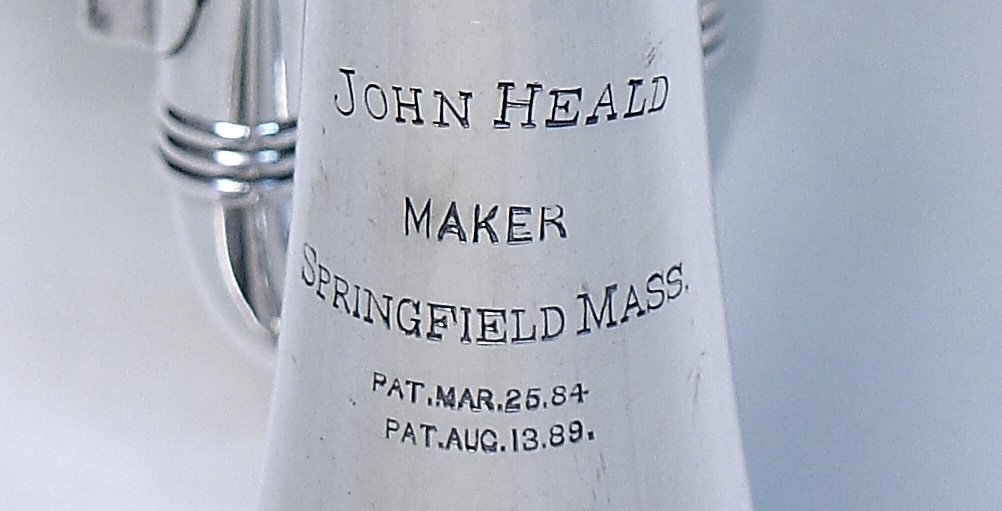Bb Cornet by John Heald
John Heald was born in 1843 into a family already active in US brass bands. His father, Paul, played the keyed bugle and was the original owner of the earliest valve brass instrument known to have been made in the US. It was called the "Permutation Trumpet" made by Nathanial Adams in Lowell Massachusetts, in 1825. John learned to play the keyed bugle and cornet in his youth and moved to Worcester 1863, eventually working for Isaac Fiske in that city.
Heald was granted his first patent in 1882 while working for C.W. Hutchins in Springfield Mass covering a waterkey actuated by a lever for the fingers of the left hand while in playing position. Hutchins was a music store and importer of European instruments that was also where John Heald made cornets using valve assemblies imported from Paris, under the Hutchins name. In 1884, Heald was granted a patent for another waterkey design that was much simpler but equally effective. This design is pushed with the thumb of the right hand and can be seen on this cornet. The last photo below shows a Conn Wonder cornet with this type of waterkey (Nick DeCarlis collection). It is not known if Conn had permission to use this patented design but they are only seen on Wonder cornets from about 1885 to 1887.
John Heald spent a short time in Philadelphia in the late 1880s, presumably working for Henry Distin and/or J.W. Pepper. He probably didn't make complete cornets until about the time that he applied for his next patent in 1889. This covered the shape of the tubing through the valves seen here and avoided some of the sharp curves in earlier valve designs. This cornet was made in about 1900, shortly after the patent that covered the design of the combination tuning slide, A change slide. The key is changed from Bb to A without disturbing the main tuning slide.
When trumpets were first offered, as illustrated in the 1903 Heald catalog, they utilized the same valve design as the cornets. However, all known examples have valve sections made by H.N. White (King). The last of these have valve section that appear to be identical to those used in White's Cleveland and American Standard brand cornets and trumpets while retaining the patented A change slide. The later, long model, cornets also have valve sections made by White.
Heald continued in business until he sold the company in 1927, when (as stated in The New Langwill Index), the name was changed to Springfield Band Instrument Company, although I don't know of any instruments marked with this name. Former Heald employee, W.H. Brittain, also made cornets under his own name in Springfield.
Heald remained a small shop, making high quality cornets and eventually expanded to trombones and trumpets but never any larger valve instruments. He was able to sell his cornets at the same price as his larger competitor, Boston Musical Instrument Manufactory. The price was $65 for a silver plated cornet but this was a premium price compared to the Conn Wonder at $50 with similar finish but including gold inside the bell. The price for this cornet with the gold trim was $72 and a few dollars more for the owners name to be engraved on the bell and nameplate on the case.
Heald's cornets are highly regarded by the few modern players that have had access to one. I had the opportunity to work on Graham Young's instruments late in his life. He had two cornets that he loved playing: a Benge with shepherd's crook bell made for him in the early 1950s and a Heald very much like this one. He told me that he played all the cornet solos in "The Great Waldo Pepper" on the Heald because it got such a great cornet sound and was a joy to play.
This cornet plays a bit flatter than modern pitch (A=440Hz) with the existing shank. At least one Heald cornet that has come through my shop had three different length Bb mouthpipe shanks, the longest being the same length as this one and also playing lower than modern pitch. I believe that Heald's clientel were largely professional musicians that were more likely to play at lower pitches than those of the amateur bands that dominated the market.
This cornet is 13 1/4" long with the shank removed, the bell rim diameter is 5" and the bore measures .470".






